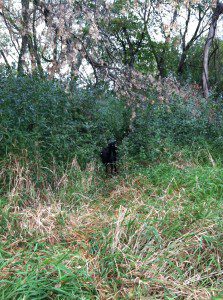 A monk said, “I’ve just arrived here and I beg the master to point out a gate whereby I may enter.”
A monk said, “I’ve just arrived here and I beg the master to point out a gate whereby I may enter.”
Xuansha said, “Do you hear the sound of the water in the creek?”
The monk siad, “I hear it.”
Xuansha said, “Enter here.”
There’s some superbly simple Zen directions, echoed by Ginny White in The Zen Leader: 10 Ways to go From Barely Managing to Leading Fearlessly: “Relax, enter, add value” is her first Zen flip.
We’ve been working with that here in our practice period.
Lot’s of popular Zen begins and ends with “relax.” To enter the stream, however, it’s necessary to go beyond that and Enter!
The how of entering is another matter. We’re so trained to split from the phenomena before our eyes and ears and take a position like political talking heads – not in the game, just observing, taking sides, and blathering.
Nothing wrong with that, of course. Kinda fun. But the witness position does not exhaust the capacity for human life. It is also painfully conducive to conflict.
So first, relax. Whatever practice we’re working with – breath, shikantaza, mu, or other koans – requires that we relax and develop the softness of the quiet, gentle observer. Then the capacity to drop the observer and enter fully is possible.
Here’s a little Dogen on the importance of entering:
The right view path limb is hiding the body within an eyeball…. Those who do not hide the body within an eyeball are not buddha ancestors.
Instructions for entering the eyeball or entering the stream are scant by design. It is a creative process from start to finish and especially in the finish – “add value.” Xuansha in the interaction above wonderfully adds value by pointing to the entry point – “Enter here.”
Adding value is implicit in our interactions with one and other. In a conversation, for example, the very nature of the process is to engage and add value. How about in a dharma context?
Xuansha shows one moment of adding value in his “enter here.”
Dogen often shows adding value by entering koan narrative and then adding value by giving life to the mosaic of metaphors. For example, here Dogen points to this dynamic practice by adding value in the koan narrative, mixing and matching four or five different koans and fragments of Zen literature:
The power of mindfulness is to be a coarse person by grabbing another’s nostrils. Thus, nostrils grab the person. It is to hurl a pearl and attract a pearl, to hurl a tile and attract a tile. Not yet hurling is worth receiving thirty blows. Even if people in the world use it, it will not wear out.
And how about in our everyday life?
The other day at work in the school in which I’m an administrator I was trying to diffuse a conflict between two groups of young woman, some with babies. I spoke with one of the young women at the center of the conflict who especially hated one of the other young women. Ironically, all of these young woman are in very similar life situations. She opened up in stream-of-consciousness style at 90 miles-an-hour, describing in wrenching detail the source of the conflict going back to the sixth grade and then racing through the next several years of incidents involving rocks in socks (a nasty weapon), baby-daddies and baby-mommies, groups of kids showing up at her house at 2am, etc.
When she paused to take a breath, I said, “Wow. I’m so concerned for you with all this violence surrounding you. It seems like you’re racing down a dead-end street and the ending can’t be good for you. Even if it is all someone else’s fault, still the outcome may not be good. How can we help you find a good solution?”
“A good solution,” she shot back, “will be when I finally kick that little bitch’s ass for good.”
Sometimes adding value is not so easy.
The practice is to give it our best anyway.











